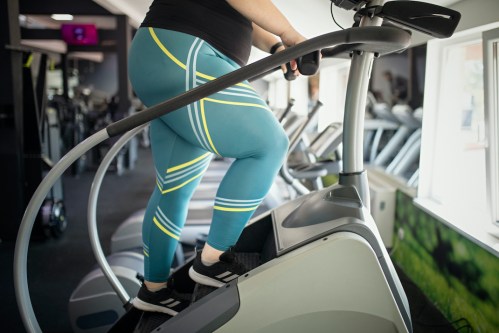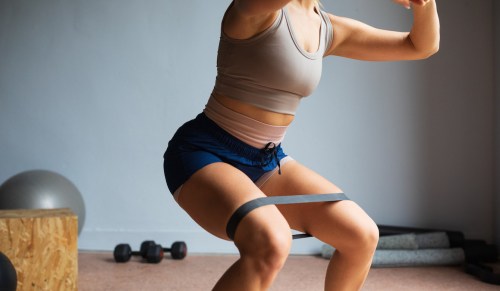On a recent trip to Los Angeles, I got a chance to try my first bootcamp class that used a StairMaster vs. a treadmill for its cardio component. I’d bought an intro pack to Bünda (pronounced boon-duh), a group fitness studio that combines weight lifting and step climbing. After only a few minutes on the machine, I could already feel my cardiorespiratory system kicking into higher gear—even though we weren’t moving fast. I was winded and a pool of sweat started to form inside my sports bra, behind which my heart was beating right in time to the high BPM playlist bumping through the speakers.
Experts in This Article
trainer and head of product &
master trainer at Aaptiv
creator and co-founder of Bünda
celebrity trainer and fitness coach
By the end, I was convinced that what trainers have been saying for years is true: Stairmills like the StairMaster are the most effective (and most underrated) cardio machine. But my time at Bünda also made me curious about how the benefits of getting your steps in on a StairMaster compare to something like the 12-3-30 treadmill workout, since the two forms of cardio seem so similar.
Climbing on a StairMaster vs. treadmill walking on an incline—do they work the same muscles?
No matter which machine you choose, you’re going to primarily work your lower body. “Walking with incline…strengthens the muscles in your posterior chain, aka the muscles from your calves up to your back,” Aaptiv master trainer John Thornhill previously told Well+Good about incline walking. Not only can walking strengthen your body, but studies have shown1 it can reduce your likelihood of heart disease, and helps to lower anxiety.
Katie Lunger Lilly, CSCS, creator and co-founder of Bünda confirms the StairMaster also helps to strengthen your lower body. In both cases, if you opt to not hold onto the handrails, you’ll also work your core and stabilizer muscles as well since they’ll need to fire to help you keep your balance.
Both cardio machines are lower body strengthening, adds Kollins Ezekh, personal trainer and owner of Members Only gym. “The StairMaster targets and strengthens muscles in the lower body, including quadriceps, hamstrings, glutes, and calves.” Similarly, the treadmill “engages the lower body muscles, including quadriceps, hamstrings, glutes, and calves, aiding in strength and endurance.”
StairMaster pros and cons
Both machines can offer low-impact cardio, but Seth Maynard, former director of training center Switch Playground in New York City, previously told Well+Good that the StairMaster “is easier on the knees,” thus, StairMaster is lower impact than a treadmill.
Lunger Lilly agrees. It’s a big part of why she created Bünda’s workouts with a StairMaster vs. an incline treadmill. “The main reason why I love the StairMaster moreso than a treadmill is because the StairMaster, while it is really metabolic, it’s less impact on the joints,” she says. When climbing stairs, you’re putting weight into a bent leg, and then straightening up, whereas on a treadmill you’re more likely to step onto a straightened knee, which puts more pressure through the joint.
You’ll also feel your heart rate spike almost as soon as you step on the machine. “The StairMaster provides an intense cardiovascular workout, increasing heart rate and improving endurance,” says Ezekh. “It’s ideal for those focusing on lower-body strength and looking for an intense cardiovascular workout.”
Unless you live somewhere hilly like San Francisco or Seattle, another stair stepper benefit is that it’s going to better mimic an everyday movement pattern most people use more regularly—stepping up stairs—which makes the workout more functional than walking on an incline treadmill.
However, Ezekh notes that there are some cons: the StairMaster provides limited upper body engagement. Also, the intensity of the machine may be too much for some beginner fitness enthusiasts. If that’s the case, starting out on a mini stepper may be a good option.
Treadmill pros and cons
There are many treadmill benefits, including its versatility: You can choose from a wide range of speed and incline variations. “It mimics a natural walking/running motion, and you can control the intensity,” says Ezekh. Likewise, a treadmill allows you flexibility—you can get a great walking or running workout inside, regardless of the weather.
Similar to the StairMaster, the treadmill can offer a solid cardio session while working several muscle groups, says Ezekh. “Quadriceps: thigh muscles engaged during pushing off; hamstrings: muscles at the back of the thighs used for pulling the legs back; glutes: buttocks muscles engaged during the push-off phase; and calves: lower leg muscles used during the push-off,” he says.
It also uses your core for stabilization and posture. In that way, it can also count as a workout for abs. Incorporating arm movements or small weights into the workout will add an upper body component as well.
However, the cons of working out on a treadmill include a higher impact on your joints, especially if you’re using the treadmill to run. “There is also limited muscle variation compared to StairMaster,” adds Ezekh.
Is the StairMaster or treadmill better for weight loss?
Even though both workouts are high intensity, if you were to be moving at the same pace on both machines, you’re going to use more energy on a StairMaster because it requires more effort to climb stairs than it does to walk up an incline. “Both the StairMaster and treadmill can contribute to weight loss,” says Jo Gomez, fitness trainer and head of product & talent at Ambition in NYC. “The effectiveness depends on factors like your workout intensity, duration, and diet.”
Why is the StairMaster so effective?
Working out on a StairMaster will build muscles, plain and simple. “The StairMaster is highly effective due to its ability to engage multiple lower body muscle groups while simultaneously providing an intense cardiovascular workout,” says Gomez. “Its low-impact nature makes it accessible to a wide range of users, reducing the risk of joint strain and injury. Additionally, its versatility, calorie-burning potential, and mental engagement factor contribute to its reputation as an efficient and motivating exercise option.”
But this machine can be challenging, and hard to keep up with for long. Is 10 minutes on the StairMaster enough? Climbing stairs for 10 minutes will definitely get your heart rate up and your butt muscles burning. Of course it depends on your fitness level, but Gomez says you can really make the most of a short time by making it a HIIT workout.
“To make a 10-minute session on a StairMaster—or treadmill—effective, focus on high-intensity interval training (HIIT),” says Gomez. “Alternate between short bursts of intense effort and brief recovery periods. Additionally, adjust the incline, resistance, or speed to increase the challenge and engage more muscle groups. Finally, maintain proper form, warm up, and cool down for a well-rounded and efficient workout in a short timeframe.”
Is it better to do StairMaster or treadmill?
In terms of offering a lower-impact, higher-intensity workout that’s more functional—with a bigger metabolic bang for your buck—the StairMaster comes out on top. But, as Lunger Lilly says, an incline walking workout is a close second. And ultimately, which cardio machine is the best choice for you will come down to your fitness goals and which piece of equipment is most accessible—and enjoyable for you.
Paluch, Amanda E et al. “Prospective Association of Daily Steps With Cardiovascular Disease: A Harmonized Meta-Analysis.” Circulation vol. 147,2 (2023): 122-131. doi:10.1161/CIRCULATIONAHA.122.061288
↩︎
Sign Up for Our Daily Newsletter
Get all the latest in wellness, trends, food, fitness, beauty, and more delivered right to your inbox.
Got it, you've been added to our email list.











